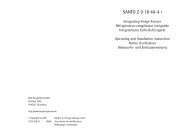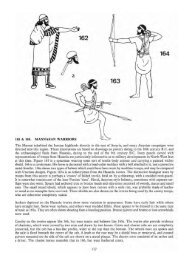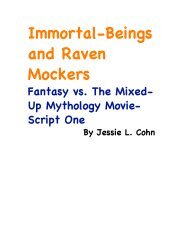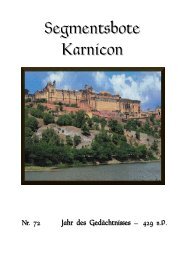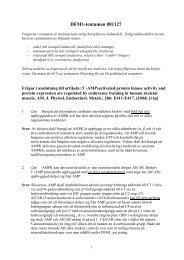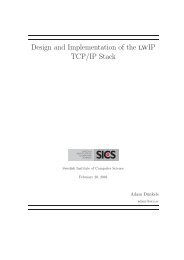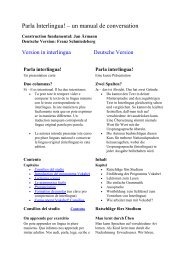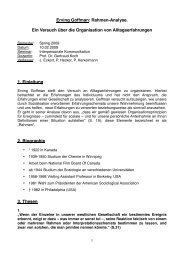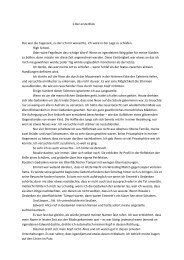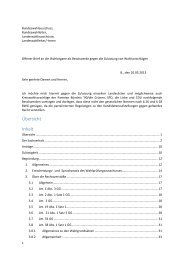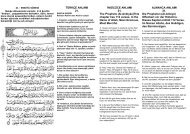Crump-W - Xmas Encyclopedia - Germany - 2006.pdf - Wikia
Crump-W - Xmas Encyclopedia - Germany - 2006.pdf - Wikia
Crump-W - Xmas Encyclopedia - Germany - 2006.pdf - Wikia
You also want an ePaper? Increase the reach of your titles
YUMPU automatically turns print PDFs into web optimized ePapers that Google loves.
The<br />
Chrflstmas<br />
trncycnopedfla<br />
Second Edition<br />
William D. <strong>Crump</strong><br />
ccr<br />
F<br />
McFarland & Company, Inc., Pubiishers<br />
leffercon, North Carolina, and London
the 1880s after a work by an artist identified<br />
Wesley, Hark! The Herald Angels Sirg (New<br />
Illustration research and selection by Linda Campbell Franklin<br />
Library of Congress Cataloguing-in-Publication Data<br />
<strong>Crump</strong>, William D., 1949-<br />
The Christmas encyclopedia / by William D. <strong>Crump</strong>.<br />
P.<br />
-<br />
cm.<br />
Includes bibliographicai references and index.<br />
2nd ed.<br />
ISBN 0-7864-2293-9 (illustrated case binding : 50# alkaline paper)<br />
@<br />
1. Christmas-<strong>Encyclopedia</strong>s. I. Title.<br />
GT4985.C74 2006<br />
394.2663'O3<br />
-dc22<br />
2OOsO2534g<br />
British Library cataloguing data arc available<br />
@2006 William D. <strong>Crump</strong>. All rights reserved<br />
rm<br />
ng<br />
Cover image @2005 BananaStock<br />
Manufactured in the United States of America<br />
McFarland 6 Company, Inc., Publishers<br />
Box 611, leferson, North Carolina 28640<br />
www.mcfarlandpub.com
177 GermanY<br />
ler. Produced and<br />
L, /r., and lules Bass.<br />
on. VHS: Wamer<br />
I is fulther detailed<br />
ok, The Enchanterl<br />
ts; Frosty the Snotv<br />
owrnan (televisior.r<br />
rrstrnas Cartootrs;<br />
;trnas in luly; Win_<br />
oi from the regior.r<br />
e arisen during the<br />
ntury. Held as the<br />
om Spain, it has<br />
rslations, the bestthis<br />
joyful Christn."<br />
Another opens<br />
and-trventl', fnm,<br />
vo or three verses,<br />
n, the first line is<br />
um, fum, furl,"<br />
erse . It is thought<br />
rn" irlitate either<br />
e strumming of a<br />
ion, th. carnl .oll.<br />
'tmas Day' a1d to<br />
ven, Who brings<br />
scratcher that h;<br />
:ding to Garfieic<br />
e not nearir- _<br />
:eived an Emr::<br />
Animated prr<br />
, Thom Hug:<br />
Ha|rington, l,:<br />
tnd Lou Rirrr-,<br />
" .ien by lim Davis. Produced and directed<br />
' lhil Roman. A Phil Roman Production in<br />
-.-rciation rvith United Media-Mendelson<br />
: -Luctions and Parvs. VHS: Twentieth Cen-<br />
For Video. 24 min.<br />
lhe Gathering<br />
11977). Made-for-television drana with<br />
: : sequel.<br />
Having sacrificed a fulfilling family life<br />
i :. the pursuit of success, Adam Thornton<br />
:irr-ard Asner), president of Thornton Indus-<br />
.-::s, suddenly faces Christmas with the news<br />
.l:t he is tenninally ill. Though estranged<br />
::-:m his four grown children and separated<br />
':rrn his n'ife Kate (N4aureen Stapleton) for<br />
-;rs, Adam solicits Kate's help to reunite the<br />
:mily one iast tir.ne at Christmas before he<br />
,:es. His children, Julie (Rebecca Balding),<br />
; (Laivrence<br />
'rm<br />
Pressman),P.ggy (Gail Strick<br />
:ncl), and Adam "Bud" Jr. (Gregory Harrir.-rn),<br />
are scattered across the continent. A<br />
r-qretful Adam especially lvishes a reconcilia-<br />
.lon lvith Bud, iris youngest, rvhose sentiments<br />
--qainst the Vietnam War had offended Adam<br />
:.r the point that he had expelled his son from<br />
rome. Bud had then left the country and fled<br />
.o Canada under a false identity to escape the<br />
.lraft.<br />
After Kate issues the invitations, taking<br />
:are oniy to plead that Adam wishes to see his<br />
- hildr en again (he would not have them return<br />
:imply because of his illness), she and Adam<br />
:.rtrke preparations by decorating the family<br />
rorneplace and the Christmas tree together, as<br />
.hough they had never separated. The hoiiday<br />
.prrit overtakes Adam, who, rummaging<br />
:hrough the attic for toys to give to his grand-<br />
:hildren, finds and repairs a doll house and an<br />
:lectric train.<br />
On Christmas Eve, the three older chill:en<br />
arrive with their families to fellowship,<br />
. ,i e, carols, and a rendering of 'A Visit frorn<br />
... Nicholas," al1 of rvhich Adam considers<br />
- -rite a miraculous event, given his neglect of<br />
rrmer days. Only Tom suspects his father's<br />
:rotives for calling everyone together rvhen<br />
:.dam, opening a gift box of firelvorks from Dr.<br />
'.rhn Hodges (John Randolph), refers to him as<br />
:ny doctor," an unusual phrase for the self-<br />
:;liant Adam. Yet Tom keeps the secret, and<br />
the two are drawn closer as they light up the<br />
Christmas Eve darkness with Iireworks.<br />
Bud's arrival on Christmas Day brings the<br />
long-expected meeting and forgiveness, along<br />
lvith two new family tlembers rvhom Adam<br />
has never seen: Bud's wife Toni (Stephanie<br />
Zimbalist) and infant son, christened Adam<br />
Thornton III that same day in a hotne ceremony.<br />
Before everyone departs, Adam's last acts<br />
of generosity include offering Bud and Julie's<br />
unemployed husband, George (Bluce Davison<br />
), posilions in his company.<br />
In 1978, this program won an Emrny for<br />
Outstanding Drama Special and received Emrny<br />
nominations for Outstanding Art Direction,<br />
Outstanding Directing, Outstanding Lead<br />
Actress (Stapleton), and Outstanding Writing.<br />
With Salah Cunningham, Veronica<br />
Hamel, lames Karen, and Edward Winter.<br />
Written by Iames Poe. Produced by Harry R.<br />
Sherman. Directed by Randal Kleiser. Hanna-<br />
Barbera Productions. VHS: Goodtimes Home<br />
Video. 94 min.<br />
A sequel, The Gathering, Port II, followed<br />
in 1979. Kate assumes control of Thornton<br />
Industries and receives amorous advances from<br />
a wealthy industrialist (Efrem Zimbalist, Jr.),<br />
lvho wishes to buy the business. The Thornton<br />
children are not sure ofthis suitor's true intentions<br />
and rally at Christmastime to protect<br />
Kate. \A/ritten by Harry Longstreet and Renee<br />
Longstreet. Produced by Ioel Rogosin. Directed<br />
by Charles S. Dubin. Hanna-Barbera Productions.<br />
Video N/A. 98 min.<br />
See also Christmas Eve (1986), a later television<br />
drama which closely parallels The Gatherlng.<br />
Gentle Mary Laid Her Child<br />
See Good King Wenceslas (song)<br />
George Balanchine's "The<br />
Nutcracker"<br />
See The Nutcracker<br />
<strong>Germany</strong><br />
'Ihis nation has enjoyed Christmas since<br />
the eighth century, rvhen the English Benedictine<br />
missionary Winfrid, St. Boniface (c.675-<br />
754), brought Christianity to the Germanic<br />
tribes of Europe. It is the country from which
Germnany<br />
178<br />
Knecht Ruprecht or Krampus, the devilish companion<br />
of St. Nicholas who carries the toy bag and<br />
helps St. Nick decide who is to get a gift, nnd who<br />
is to be punished. OId engrailng reprinted in Phillip<br />
Snyder, The Joys of Christmas Past: A Social History<br />
(New York: Dodd, Mead, 1985).<br />
a number of worldwide holiday customs originated<br />
(for example, Advent wreaths, Advent<br />
candles, Advent calendars, and Christmas<br />
trees), richly interwoven with pagan rites of<br />
pre-Christian times.<br />
Christmas is preceded by Advent and its<br />
associated customs and symbols. Also commencing<br />
at this time is the Christkindlnnrkt<br />
(Christ Child market), a large, open-air market<br />
hosted in virtually every German city,<br />
sporting all manner of Christmas merchandise.<br />
The largest and most famous of these markets<br />
is that in Nuremberg, an annual tradition of<br />
more than 400 years. Roman Catholics erect a<br />
Krippe (crib), a Nativity scene, in churches and<br />
homes. Often these displays are heirlooms featuring<br />
wooden figures hundreds ofyears old,<br />
hand-carved by family ancestors.<br />
On December 5, the eve of St. Nicholas's<br />
Day, men dressed as the bishop St. Nicholas in<br />
fuil clerical attire ride about cities on white<br />
horses, while children set our their shoes for<br />
the saint to fill tvith toys and treats overnight.<br />
A St. Nicholas personage usually visits homes<br />
in neighborhoods for the traditional quizzing<br />
ofchildren in church doctrine and the assessing<br />
of their behavior over the past year. Accompanying<br />
St. Nicholas is a personification of<br />
Satan, known, depending on the region, by a<br />
host of names such as Knecht Ruprecht, Krampus,<br />
Grampus, Hans Muff, Hans Trapp, Butz,<br />
Klaubauf, Bartel, Budelfrau, Pelznickel, Belsnickei,<br />
Habersack, Klaasbuur, Burklaas, Rauklas,<br />
Ru-klas, Bullerklaas, Aschenklas, Shaggy<br />
Goat, or simply Rider. A hideous, fur-clad<br />
figure with biackened face, dark beard, long<br />
tail, and red, serpentine tongue, this antithesis<br />
of St. Nicholas growls, rattles chains, and sports<br />
a whip with which to "beat" naughty children<br />
and those ignorant of their catechism. Some<br />
characters tote bags or baskets in which they<br />
threaten to stuff and whisk away the Iittle<br />
offenders. Traditionally, as the Satan figure is<br />
A German youth, perhaps a baker's boy, carries perhaps<br />
a Weihnachtstollen, Stollen, or fruit loaf<br />
under each arm. From the German magazine<br />
Deutscher Kinderfreund, 1910.<br />
about to spring,<br />
saves the children<br />
In their shoes on<br />
children find swit,<br />
the Evil One.<br />
St. Nicholas's<br />
of pagan rituals.<br />
Nichoias personag<br />
ceremonies, recal<br />
Yule festivals, wL<br />
alvay the spirits c<br />
sheaves and wearir<br />
tenmandelhaut (I<br />
Bavarian Alps rur<br />
din with cow bell<br />
they symbolically,<br />
pagan beliefthat n<br />
rvould drive away t<br />
lowing this comm<br />
oring St. Nichola<br />
accompany the sair<br />
to house deliverinS<br />
a scene derived fr,<br />
Riddle-Raddle Mr<br />
carry the single wc<br />
On the three I<br />
Bavarian childre<br />
iKnocking Nights<br />
loween in the Uni<br />
they go about crea<br />
ble to banish evil s<br />
beginning with the<br />
lisited, the childrr<br />
the host.<br />
By Christmas<br />
completed, featuri<br />
gerbread men a<br />
Springerle (cooki<br />
Lebkuchen (spiced<br />
Stollen (candied fr<br />
.fernilsse (pepper<br />
lAachen almond<br />
iaimond confectior<br />
animals or other ch<br />
their Christmas tre<br />
chiidren are not all<br />
it has been decorat<br />
gerbread or rr.atz<br />
l\lunderkerzen (spa<br />
signals that the ch.<br />
and partake ofthe
179<br />
Genrnany<br />
ve of St. Nicholas's<br />
hop St. Nicholas in<br />
rut cities on white<br />
lrr their shoes for<br />
d treats overnight.<br />
sually visits homes<br />
:aditional quizzing<br />
ine and the assess-<br />
3 past year. Accompersonification<br />
of<br />
rn the region, by a<br />
t Ruprecht, Kram-<br />
Hans Trapp, Butz,<br />
r, Pelznickel, Belrr,<br />
Burklaas, Raukschenklas,<br />
Shaggy<br />
hideous, fur-clad<br />
dark beard, long<br />
gue, this antithesis<br />
; chains, and sports<br />
' naughty children<br />
catechism. Some<br />
:ets in which they<br />
;k arvay the little<br />
ihe Satan figure is<br />
:*iL*-<br />
/2<br />
db<br />
(}'<br />
4\V 't/ \<br />
'r's boy, carries perllen,<br />
or fruit loaf<br />
refftlAfi ttLgqztne<br />
:bout to spring, St. Nicholas intervenes and<br />
laves the children from a fate worse than death.<br />
,n their shoes on St. Nicholas's Day, naughty<br />
:hildren find switches, coal, or dirt, gifts from<br />
:he Evil One.<br />
St. Nicholas's Day continues with vestiges<br />
,rf pagan rituals. In southern <strong>Germany</strong>, St.<br />
\icholas personages lead processions to bonfire<br />
:eremonies, recalling the bonfires of ancient<br />
Yule festivals, which were believed to drive<br />
arvay the spirits of dar-kness. Donning straw<br />
sheaves and wearing grotesque masks, the But-<br />
:enmandelhaur (Riddle-Raddle Men) of the<br />
Bavarian Alps run through valleys creating a<br />
din with corv bells and other noisemakers as<br />
they symbolically drive away evil, recalling the<br />
pagan belief that not only fire, but loud noises,<br />
rvould drive away the evil spirits of winter. Fol-<br />
Iowing this commotion and a ceremony honoring<br />
St. Nicholas, the Riddle-Raddle Men<br />
accompany the saint as he journeys from house<br />
io house delivering gifts to children. Finally, in<br />
a scene derived from pagan fertility rites, the<br />
Riddle-Raddle Men enter homes and simply<br />
carry the single women outdoors.<br />
On the three Thursdays before Christmas,<br />
Bavarian children observe Klopfelnachten<br />
(Knocking Nights), a ritual similar to Halloween<br />
in the United States. Wearing masks,<br />
they go about creating as much noise as possible<br />
to banish evil spirits. After reciting rhymes<br />
beginning with the work "knock" at each home<br />
visited, the children then receive treats from<br />
the host.<br />
By Christmas Eve, the seasonal baking is<br />
completed, featuring such confections as gingerbread<br />
men and gingerbread houses,<br />
Springerle (cookies with raised designs),<br />
Lebkuchen (spiced cookies with candied fruit),<br />
Stollen (candied fruit loaf or fruit cake), Pfeffernilsse<br />
(pepper ntls), Aachener Printert<br />
(Aachen almond biscuits), and marzipan<br />
(almond confection molded into the shapes of<br />
animals or other characters). Families decorate<br />
their Christmas trees behind closed doors, and<br />
children are not allowed to view the tree until<br />
it has been decorated with the traditional gingerbread<br />
or marzipan figures, candles, and<br />
Wunderkerzere (sparklers). A tinkling bell then<br />
signals that the children may enter the rootn<br />
and partake ofthe tree's culinary delights.<br />
Children also receive gifts on Christmas<br />
Eve, the traditional gift-bearer being either the<br />
Roman Catholic Christkindl (Christ Child) or<br />
the Protestant Weihnachtsmann (Christmas<br />
Man). These spirits sprang from the influence<br />
of Martin Luther (1483-1546), the German<br />
Roman Catholic priest who initiated the<br />
Protestant Reformation. Observing that the<br />
Church made much ado about honoring St.<br />
Nicholas at Christmastime, Luther strongly<br />
advocated a Christ-centered season with far<br />
less emphasis on the saint. After the Reformation,<br />
Catholics adopted the concept of the<br />
Christkindlein ("little Christ Child," Iater<br />
shortened to Christkindl) as the Christmas giftbearer,<br />
yet it was inconceivable to imagine the<br />
Son ofGod in such a role. Therefore, tradition<br />
has heid that an angelic messenger brings the<br />
gifts instead. Also confusingly termed the<br />
Christkindl, this spirit is depicted as a little girl<br />
with golden wings, clad in a white robe and<br />
jeweled crown, and who carries a tiny fir tree,<br />
a symboi of eternal life. The Christkindl supposedly<br />
helps to decorate the Christmas tree'<br />
and it is she who rings the bell when all the gifts<br />
are spread beneath it. The Protestants, on the<br />
other hand, rejecting all saints and Churchsanctioned<br />
entities as gift-bearers, created the<br />
Weihnachtsmann as an altered conception of<br />
St. Nicholas. His appearance is remarkably<br />
similar to that of the American Santa Claus.<br />
In past centuries, parents in northern German<br />
villages sent their children's gifts to one<br />
man who, attired as Knecht Ruprecht, visited<br />
all the village homes on Christmas Night in the<br />
name of his master Jesus. After hearing an<br />
account of the children's behavior, he either<br />
distributed the gifts or presented the parents<br />
with a rod and urged them to discipline the<br />
naughty ones.<br />
In Bavaria on Christmas Eve, the Berchten<br />
Runners (named for Berchta, a variant of<br />
Hertha, Norse goddess of the home) don<br />
grotesques masks and parade about, rhetorically<br />
asking what people have done for them<br />
during the year. Makers of mischief, they must<br />
be placated with gifts. In the city of Berchtesgaden,<br />
the minutes before midnight ring with<br />
gunfire as shooters attempt to drive away the<br />
last remaining evil spirits before Christmas<br />
arrives. Around most of the country, it is cus-
Gerrnany<br />
180<br />
'T3<br />
:
181<br />
Gesu Barnbino<br />
dd<br />
)<br />
F<br />
/a<br />
tA<br />
g-\.:'<br />
)<br />
, tlteir cats, ttnd<br />
e Gerntan magtomary<br />
to visit the graves of loved ones on<br />
Christmas Eve and place lighted candles or<br />
smali Christmas trees with candles by their<br />
tombstones. Another Christmas Eve custom is<br />
Herbergsuchen ("searching for Shelter"), a custom<br />
similar to the Latin American Las Posadas,<br />
in which gr-oups reenact the Holy Couple's<br />
search for shelter in Bethlehem and which terminates<br />
with Mitternachtsmette (Midnight<br />
Mass) (see Las Posadas).<br />
Christmas Eve dinner may consist of roast<br />
goose with stuffrng, turkey, carp, Sptitzle<br />
(dumplirrgs), Kdniginpasteten (meat-filled<br />
"kings' pastries"), vegetables, Bayerisches Kraut<br />
(Bavarian red cabbage), potato salad, spiced<br />
cakes, Sfollerz, marzipan, assorted cookies, and<br />
wines. Protestant church services are held in<br />
the afternoon or evening, Catholics attend<br />
Midnight Mass, and Turmblasen (brass ensembles)<br />
herald the coming of Christmas as thel'<br />
play chorales from church towers. This latter<br />
tradition, called "Blowing in the Yule [or<br />
Christmas]," is often repeated on New Year's<br />
Eve (see Blowing in the Yule).<br />
Christmas Day is spent in resting and visiting<br />
farnily members. December 26, "Second<br />
Christmas Day" (St. Stephen's Day), is a legal<br />
holiday. Because St. Stephen is the patron saint<br />
of horses, many cities host mounted processions<br />
in honor of this saint.<br />
The 12 days of Christmas, from Christmas<br />
Da1' 1s Epiphany (January 6), are known as Dle<br />
Ztvdlf Raucltntichte ("The Twelve Smoking<br />
Nights"), a vestige of Jul (Yule), so named<br />
because it is customary during this period to<br />
burn incense and build bonfires, the smoke of<br />
which was once believed to dispel evil spirits at<br />
Yuietide. Additionally, people wear demon<br />
masks and make loud noises.<br />
New Year's Eve, St. Syh'ester's Day, honors<br />
the early fourth century Pope St. Sylvester<br />
L Typically featured are gunfire, firervorks,<br />
other forms of noisemaking, and parties. Citizens<br />
of Bavaria tr.rrn off their lights just prior<br />
to midnight, then turn them on to welcome the<br />
new year.<br />
Community parties on E,piphany often<br />
feature two pastries, each with a single bean<br />
baked inside, which derive from medieval<br />
Twelfth Night customs. The man and woman<br />
finding the beans become the Bean King and<br />
Queen of the event and are vested with authority<br />
to issue ridiculous commands, which all<br />
guests must obey. Should the king and queen<br />
both be single, superstition holds that theywill<br />
eventually marry. Other superstitions include<br />
the consecrating of salt and chalk. The salt is<br />
fed to the livestock, and with the chalk people<br />
write the traditional names of the three Wise<br />
Men, Melchior, Gaspar, and Balthazar, on their<br />
homes, thus providing protection for their<br />
property. In Bavarian Processions of Light,<br />
people carry torches and lanterns through the<br />
stleets and light bonfires on mountains.<br />
Sternsinger (star singers), groups dressed as the<br />
Magi, make rounds singing carols, and one<br />
person carries a lighted star on a pole. Pastors<br />
bless homes rvith holy water, by burning<br />
incense, and by writing "G+M+8," the Magi's<br />
initials, on door posts.<br />
"Merry Christrnas" in <strong>Germany</strong> is Frbh-<br />
Iiche Weihnachten.<br />
See also Advent; Christrnas Tlee; Epiphan1,;<br />
Saint Nicholas; Saint Nicholas's Day;<br />
Yule.<br />
Gesu Bambino<br />
("The Infant Jesus"). Best-known conposition<br />
of the Italian American organist and<br />
composer Pietro A. Yon (1886-1943). Originally<br />
r,vritten in Italian, with an English version<br />
provided by Frederick Martens, "Gesu Bambino"<br />
centers around the Nativity, recalling the<br />
legend of florvers biooming at Christ's birth<br />
("When biossoms flowered 'mid the snows")<br />
and applying other metaphorical attributes<br />
such as the "Christmas Rose" and "King of<br />
Love and Light" to the Child. Following each<br />
verse is the familiar refrain to the carol'Adeste<br />
Fideles": "O come, let us adore Him, Christ the<br />
Lord." The carol's populality is atteste d by the<br />
various vocal and instrumental arrangements<br />
that have appeared.<br />
Pietro A. Yon served as organist for St.<br />
Peter's in Rome (1905-1907), after rvhich he<br />
immigrated to the United States. Securing<br />
posts as an organist in New York City, first at<br />
St. Francis-Xavier's (1907 -\9I9, 192l-1926),<br />
then at St. Patrick's Cathedral (a post held for<br />
sorne 17 1'ears until his death), Yon was<br />
renorvned as an organist, composer, and<br />
teacher. In addition to numerous organ coln-



